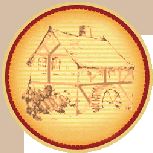by Les Saidel - January, 2012
Ancient mariners used to think the world was flat, that if you sailed far enough you would fall off the edge. To ancient bakers, bread was also flat.
Since the discovery of fire, the oldest type of bread known to man was made from a flour/water mush, rolled flat and draped on a fire heated stone or rock to bake. The "cracker" texture of such bread was very similar to what we know today as Jewish Matzo.
From the Cradle of Civilization, Mesopotamia, originated the breads of antiquity, flat breads that persist in that region until this very day. One morning, after forgetting her dough from the previous day, an ancient Egyptian housewife discovered that the dough was inflated with air and leavened bread was discovered. Ancient Egypt with its farmlands surrounding the Nile Basin became the grain supplier of the world and the frontrunner of the baking profession of the time, leavened bread being their expertise. Despite the discovery of leavening, most breads of the era were still flatbreads and not loaves as we are familiar with today.
To this day, all over the Middle East, the staple bread of the masses is flatbread, or what we know as Pita bread. In fact there are two main types of pita bread. The first is the so called "pocket" pita bread that is hollow in the middle and usually stuffed with delicious addendums like Falafel, known as Khubz Arabi to the natives. The second is a much larger flat bread that has no hollow center and the additional foodstuffs are instead wrapped in this large flat pita, much like a baby is wrapped in a blanket. This second type of pita is called (depending on region) Lafa, Iraqi Pita, Iranian Pita, Lavash or Khubz Saj, (after the domed iron oven called Saj that they are baked on).
There are also variations on the above two pita breads, one called Mafrooda which is the same as the "pocket" pita dough, but is pricked with a fork or a similar sharp object to prevent it from forming a hollow pocket while baking. Another is called Saluf which is very similar to the Mafrooda and traditionally eaten with Hilbeh, a thick paste made from fenugreek seeds, coriander and chili pepper.
At the end of this article you may find a "foolproof" recipe for making "pocket" pita.
The most distinctive feature of these breads is the fact that they are baked at a very high temperature (350 degrees C or more) for a very short time (less than 2 minutes). It is a thrilling experience to see pocket pita "ballooning up" in a brick oven right before your eyes in a matter of seconds. It is perhaps the most visually vivid baking spectacle that exists.
Although the Middle East may have been where it all started, flatbreads soon spread to other corners of the globe where they became part of the food culture.
Originating in Afghanistan and then migrating to India, Pakistan, Bangladesh and other countries of the region is a flatbread known as Naan. This flatbread is traditionally baked in a Tandoor, a cylindrical clay oven and gets its distinctive flavour from goats' milk yoghurt and black onion seeds.
Other flatbreads from this region include Bhakri (unleavened flatbread made with various flours), Roti/Chapati (made with stone ground whole meal flour), Pappad (a crisp, cracker-like unleavened bread), Dosai (a type of crepe) and Paratha (made by frying dough in a tava, a kind of a pan).
Injera, as it is called in Ethiopia, or Canjeero in Somalia, or Lahoh in Yemen, is a leavened flatbread made from teff grains, which are rich in iron.
An interesting flatbread from China, Sanchuisanda, is so called because of its special post baking process. The flatbread is baked in the ashes of a wood fire. The finished bread is covered with ash which is then blown and patted off. Sanchuisanda actually means "three blows and three pats".
In Thailand, Khanom Bueang is a popular crispy flatbread, similar to a Mexican Taco, but made from rice flour, not corn flour.
Swinging west now towards Europe, perhaps the most famous flatbread in the world (aside from the pita) originated in Italy and is called ... You guessed it - Pizza. Pizza, as everyone knows, is a leavened flatbread smeared with spiced tomato paste sauce, sprinkled with cheese and then topped with a variety of toppings, pepperoni, olives, onions, anchovies ... and some less known ones like shrimps in Australia, green peas in Brazil, squid in Japan, coconut in Costa Rica and curry in Pakistan.
Another similar flatbread from Italy is Focaccia, which is basically like Pizza, except without the cheese.
Sardinia is famous for its Pane Carasau, a paper thin, crisp flatbread made from Durum wheat flour, baked twice. Kept dry, this bread can last up to a year.
Crepes, Pancakes and their offshoots are popular flatbreads all over Europe, for example Blintz/Blini (Russia), Crepes (France), Pannekoeke (Netherlands), Pfannkuchen (Germany), Waffles (Belgium). These are mostly sweet flatbreads topped with sweet toppings, and are generally regarded as dessert.
In Norway, Lefse is a flatbread made from milk/cream, potato and flour and rolled flat with a specially grooved rolling pin. Another Norwegian flatbread called Flatbrod was once considered the staple diet of the Vikings.
Jet setting even further west to the Americas, we find the continent's most famous flatbread (no, not Pizza - that's Italian), the Tortilla. Mexican in origin, the Tortilla is an unleavened flatbread made from corn flour. Another less well known South American flatbread is the Arepa, an unleavened patty made from corn meal. The Arepa is traditionally grilled, fried, boiled or baked and varies in thickness according to region.
That is only a summary of the more well known flatbreads from around the world. There are a lot more, but this article is just to give you an idea of the variety that exists among the flatbread genre.
With the exception of the European flatbreads, flatbreads are more prominent in less developed countries around the globe, as opposed to more developed countries that favour inflated loaves of bread. What is interesting though is that in general, the flatbreads from the less developed countries are more nutritious than their inflated counterparts in the "civilized" world, using unrefined flours and fewer chemicals and artificial ingredients.
Sometimes there are advantages to being "uncivilized".
Now, as promised a "foolproof" recipe for making your own "pocket" pita.
(Makes 10 pita 120g each)
735g flour
440ml water
11g salt
11g sugar
3g instant yeast
Mix and knead for 10 minutes.
Leave to rise for 1 hour.
Preheat the oven to the highest temperature possible, for best results the oven should be between 350-400 degrees C. To make the best pita, it is wise to invest in a "pizza stone", obtainable in most kitchenware stores and to warm the oven with the pizza stone in.
Shape into ten 120g balls and leave to relax for 10 minutes.
Using a rolling pin, roll each ball into a flat, uniform thickness, round pita/disc shape, approximately 15cm in diameter.
Lay flat on a baking pan to rise for a further 10 minutes.
Insert in the hot oven (on top of the pizza stone) and bake for 2 minutes. The pita will balloon up.
Remove from oven, let cool and bag in plastic to prevent drying out.
Bon Appetit.
Les Saidel
© Copyright. All rights in the above articles are reserved to the author Les Saidel.
No part of this website or the above articles may be transmitted in any form or by any
means without permission in writing from the author.




